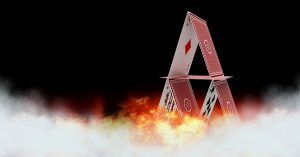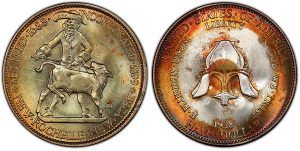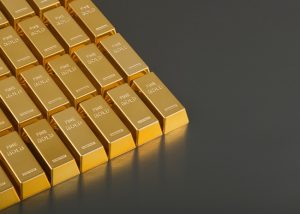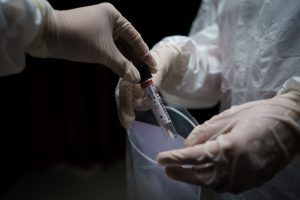Fed Pulls Back on Emergency Support to Economy
Posted on — Leave a commentNearly two years after COVID-19 hit our shores, sending our nation into an economic tailspin, the Federal Reserve announced today it is dialing back on its emergency bond-buying program.
Wall Street expected today’s announcement that the Fed would taper its monthly bond purchases. Gold registered little reaction to the news, recently trading at around $1,765 an ounce.
“In light of the substantial further progress the economy has made toward the Committee’s goals since last December, the Committee decided to begin reducing the monthly pace of its net asset purchases by $10 billion for Treasury securities and $5 billion for agency mortgage-backed securities,” the Fed said today. The Fed had been buying $120 billion in U.S. Treasury and mortgage-back securities each month since early in the COVID crisis.
The Fed kept its benchmark interest rate unchanged – at the rock-bottom 0%-0.25% level.
The Fed weighed in on inflation today, too. Americans are confronting higher prices on a range of consumer goods and inflation hit a 30-year high this year.
While the Fed has been adamant that current inflation levels are “transitory,” today’s post-meeting statement qualified that by adding in that inflation is “expected to” be temporary.
Many other economists aren’t so sure. Once inflation takes root in the economy, it can tighten its grip and spread, often ferociously.
“Our sense is that the inflation and price increases will get worse in the near term before they get better,” Kathy Bostjancic, Chief U.S. Financial Economist at Oxford Economics told CBS News today.
For now, the Fed is willing to tolerate higher inflation in an attempt to move the economy back toward full employment. Will the gamble work?
If this roll of the dice fails to produce falling inflation in 2022, the Fed will be forced to raise interest rates sharply to contain inflation. That will spell trouble, and perhaps even a stock market crash and recession. The stakes are high.
In today’s uncertain economic times, gold continues to offer investors a safe haven investment, an asset to hedge against recession and stock market volatility and also as a proven method to maintain your purchasing power in these historic inflationary times.
Want to read more? Subscribe to the Blanchard Newsletter and get our tales from the vault, our favorite stories from around the world and the latest tangible assets news delivered to your inbox weekly.
Where Are We In the Business Cycle?
Posted on — Leave a commentEconomists like to define business cycles through four stages: expansion, peak, contraction and trough.

What does this mean exactly? During an expansion phase of the economy – gross domestic product (GDP) is growing and expanding. Businesses are expanding, hiring new people, investing in their businesses and, typically, the stock market is climbing. By that definition – it’s easy to say we are in the expansion phase right now.
But have we peaked already?
Rising prices – or inflation – is a sign of the peak stage. Overconfident stock market investors is another characteristic of the peak stage. Sound familiar?
We did have a severe bear market in stocks after COVID hit last year – yet notably – it was the shortest bear market in history. (Bear markets are typically defined as a stock market pullback of 20% or more.)
Looking back, the S&P 500 hit an all-time high in February, 2020 – then plunged a shocking 34% the next month. The swift turnaround in stocks was unprecedented – by August 2020, the S&P 500 had fully recovered.
Was that bear market in stocks normal? Not even close. The average length of a bear market is 349 days with an average decline of 36%, according to Invesco.
Compare that to the 2008 Financial Crisis. The S&P 500 plunged a nasty 52% — and the bear market lasted 1.3 years.
As consumer prices on nearly everything rise now, and stocks climb – this typically signals a feverish type of peak to the expansion phase. Many believe we have already peaked. In fact, some economic data is already revealing a slowdown.
What comes next in the business cycle? The contraction phase.
Economists measure the contraction from the peak to the trough. The contraction phase officially becomes a “recession” once two consecutive quarters of negative GDP growth occur.
When was our last recession? Yep, it was last year – from February 2020 to April 2020 – lasting an unprecedented two months.
Not only did we see the shortest bear market in history last year, we saw the shortest recession in U.S. history, as measured by the National Bureau of Economic Research.
What does that suggest? Some believe that those events were so short that they hardly count. The 2020 recession wasn’t long enough to equalize the pressures of a normal business cycle.
What could that mean going forward? The next recession could be longer. Much longer.
What can trigger economic contractions and stock bear markets you might ask? Rising interest rates are a big factor. Rising interest rates tamp down consumer activity and business investment and spending. Rising interest rates also negatively affect earnings and stock prices. The idea is that higher borrowing costs means companies are paying more to service their debt, which weighs on profits.
One of the many reasons that people like you may invest in gold or are thinking about investing in tangible assets is as a portfolio hedge. Gold and rare coins are a hedge for many economic variables including a bear market in stocks.
Historically, gold becomes inversely correlated to the stock market during times of equity market stress. That means when stock prices go down sharply, historically gold prices have climbed significantly.
While many stock market investors are overconfident right now, it can be useful to step back and view the big picture. Consider where we are in the business cycle now – and consider if you are properly diversified for what comes next. If you have questions, we can help.
Want to read more? Subscribe to the Blanchard Newsletter and get our tales from the vault, our favorite stories from around the world and the latest tangible assets news delivered to your inbox weekly.
Evergrande, Counterparty Risk, and Gold
Posted on — Leave a commentIn recent weeks, the crisis within Evergrande has reminded investors of counterparty risk.
Counterparty risk is the possibility that one of the parties involved in a transaction might default on their obligations. People often use the term counterparty risk and default risk interchangeably. Default risk is the possibility that one person or company will fail to make the required payments on their debt.
Evergrande is a towering example of counterparty risk. In August of this year, the Chinese property developer warned that it would default on their debts if they were unable to raise sufficient cash in time. This news sparked fear among investors. Those fears were confirmed the following month when Evergrande failed to make their off-shore bond payments of $83.5 million. In October, the company failed to meet three more payments totaling $148 million. These defaults have left many individual Chinese investors devastated.
In recent weeks, the company has attempted to remedy the problem by selling off assets to generate the capital necessary to stay afloat.
What makes this event so concerning is that it happened during a time when China appeared to be enacting a strict regulation intended to avoid these kinds of defaults. That regulation is called the “three red lines.” This refers to China’s attempt to limit how much a company can borrow based on three metrics; the company’s debt-to-cash, debt-to-equity, and debt-to-assets. Despite these regulations, Evergrande has vaporized the wealth of many Chinese households.
Many journalists have made comparisons to Lehman Brothers, which is a similar story of counterparty risk. In fact, Evergrande and Lehman Brothers have more in common than counterparty risk gone awry. Both entities were massive institutions. Both had the appearance of a monolithic corporation that could never fail. However, the fallout from both disasters is a reminder that counterparty risk is very real. When debts go unpaid, businesses fail and investors are left holding the bag.
Gold is free from counterparty risk. As a precious metal, it does not generate cash by meeting quarterly earning estimates or by satisfying debt obligations. The value of gold comes from its scarcity, global appeal, and application in jewelry and technology. Freedom from counterparty risk is a major benefit to long-term investors because over the course of decades we are all likely to experience at least some of the effects of this risk.
Consider that total global defaults on debt were $430 billion in 2008 during the worldwide financial crisis. That is what counterparty risk looks like when things go wrong.
The most threatening risks are often those that go unseen. Counterparty risk is a perfect example. It is quiet until it can no longer be silenced and when investors finally hear it, the sound is deafening.
Want to read more? Subscribe to the Blanchard Newsletter and get our tales from the vault, our favorite stories from around the world and the latest tangible assets news delivered to your inbox weekly.
The 1938 New Rochelle 250th Anniversary Half Dollar
Posted on — Leave a commentIn 1688, the city of New Rochelle, New York was founded by French Protestants. Colonist Jacob Leisler executed the formal agreement when he purchased 6,000 acres from Sir John Pell who originally owned the land. In return for the acreage that represents the city today Pell required “one fatt calfe” on  the following year and every year after.
the following year and every year after.
More than two hundred years later the Westchester County Coin Club began to rally interest in having a 250th anniversary coin minted. Their thinking was that selling such a coin would generate the revenue necessary to host the anniversary of New Rochelle. Raising the funds this way meant they would not need to rely on tax income from citizens already suffering financially from the Great Depression.
By January of 1936 a bill calling for the coins was drafted and introduced into Congress. The bill, which authorized a mintage of 25,000 pieces, passed without debate in March of the same year.
The design perfectly tells the story of New Rochelle’s humble beginnings with a roped calf in the care of a man designed to resemble John Pell. The designer, Gertrude K. Lathrop, relied on portraits of Pell which he accessed through Pell’s descendants. The reverse of the coin shows a fleur de Lis which is a symbol found on the coat of arms for New Rochelle. The decision to include the fleur de lis was also inspired by the French city of La Rochelle which features the symbol on its coat of arms.
The final design received much praise for its authentic depiction of the history behind the town. Moreover, critics cited the artist’s ability to include many visual elements in a single coin without resorting to a cluttered, over-designed piece.
By April of 1937 minting began. The Philadelphia Mint produced just over 25,000 coins, reserving the additional pieces for assessment purposes. The coins were made available to the public for $2 each at stores and through the mail. As planned, the profits from the sale of the coins funded the anniversary celebration for the city which occurred in June of 1938. The coin has steadily climbed in value over the decades with one selling for $3,593 in 2006.
While the coin lives on in the collection of numismatists across the country, Pell’s calf agreement finally came to an end during the American Revolution. The agreement was briefly reinstated for ceremonial purposes only in 1988 during the city’s 300th anniversary. During the celebration the stubborn calf refused to be led to the stage. Four men finally succeeded in pulling the animal out. After this brief appearance the calf was allowed to return to its home on a farm in Granite Springs in Westchester County.
Want to read more? Subscribe to the Blanchard Newsletter and get our tales from the vault, our favorite stories from around the world and the latest tangible assets news delivered to your inbox weekly.
Nearly 80% of Americans Expect Inflation to Get Worse
Posted on — Leave a commentAfter nearly a decade of nearly non-existent inflation – the phenomenon of rising consumer prices is back. This spring, U.S. consumer prices saw their biggest jump since August 2008.
And, inflation is sticking around.
U.S. consumer price growth continued to climb in September, the Labor Department reported Wednesday. Over the last 12 months, U.S. consumer prices gained 5.4%.
While Federal Reserve officials continue to downplay the recent jump in prices from everything from gas to used cars and trucks to furniture, to airline flights and copper calling inflation a “transitory” effect, many Americans aren’t so sure.
A new study revealed that that 78% of Americans expect inflation to get worse over the next year, and 69% say it will negatively impact their purchasing power over the coming months, according to the Allianz Life Quarterly Market Perceptions Study, Q3 2021.
Many Americans also believe inflation will impact their retirement:
- 72% say they are concerned the rising cost of living will impact their retirement plans
- 70% say they are worried they will be unable to afford the lifestyle they want in retirement
Concerns over inflation are fueling interest in so-called “protection products” or financial assets that protect wealth against stock market declines and rising inflation. Gold investors have long relied on physical precious metals to serve both of those key portfolio functions.
The Allianz study found that people are increasingly likely to say it’s important to have some retirement savings in products that protect from market loss (70% in Q3 compared with 64% in Q2). Further, nearly three quarters (72%) say they would be willing to trade off some upside growth potential to have some protection from market loss.
Higher net worth Americans – those with investable assets larger than $200,000 – are even more likely to agree that it is important to protect retirement savings from loss (83%), and that they are willing to sacrifice gains for this protection (81%).
It’s not just inflation that people are worried about now. Fifty-four percent of Americans worry that another big market crash is in on the horizon, which is up from 45% of those concerned in the second quarter of this year, Allianz says.
Risks are rising. Stock market gains, which have been fueled by the Fed’s ultra-accommodative monetary policy, could evaporate quickly once the central bank pulls back its easy money punch bowl. Inflation is real and seemingly everywhere you look now.
Are you looking for ways to protect your hard earned retirement assets and wealth?
Gold is a protection play
If you are considering additional diversification now given the rising economic risks, consider increasing your allocation to gold, which is used as an inflation hedge and also as an effective portfolio diversifier against equity market declines. More people are now looking to gold to protect their assets.
“There’s more risk aversion in the market and gold is benefiting from that, coupled with concerns about inflation and cooling of the global economy,” Commerzbank analyst Daniel Briesemann told CNBC this week.
If stagflation talks come to the fore increasingly, gold could clock $1,900 by year-end as interest rates should remain relatively low even if the Fed starts tapering, Briesemann added.
You could benefit from a confidential portfolio review from a Blanchard portfolio manager. If you’d like personalized recommendations to match your long-term financial goals and risk tolerance levels call us at 1-800-880-4653.
Want to read more? Subscribe to the Blanchard Newsletter and get our tales from the vault, our favorite stories from around the world and the latest tangible assets news delivered to your inbox weekly.
Gold During Stagflation: Performance Explained
Posted on — 1 CommentStagflation describes an economic setting in which inflation increases while economic output slows or stops. This condition was first seen in the US in the 1970s when the country experienced five quarters of negative GDP growth.
Stagflation is beginning to surface in conversations today because economic growth appears to be weakening and inflation appears to be on the rise.
Recently, the I.M.F. issued a warning that “pandemic outbreaks in critical links of global supply chains have resulted in longer-than-expected supply disruptions, further feeding inflation in many countries.” In the same report the I.M.F. reduced their US economic growth forecast from 7% to 6% while reducing their economic growth forecast at the global level from 6% to 5.9%.
Forecasts of rising inflation have also been seen outside the I.M.F. The Federal Reserve Bank of New York’s Survey of Consumer Expectations showed that inflation expectations over the next three years have increased from 4% to 4.2%. Meanwhile, short-term expectation increased by 5.3%.
Investors are taking note of these changes because stagflation tends to lead to lower equity returns. Consider research from the World Gold Council which shows that since 1973 the S&P 500 has delivered an annualized average (stagflation) adjusted return of -6.6% during periods of stagflation. EAFE equities fared even worse during episodes of stagflation generating a return of -11.6%.
Investors are growing fearful. These negative historical returns are prompting many to seek alternative investments to offset the possible risk of a looming stagflation period. The same data reveals what assets performed well during the same stagflation periods that yielded negative returns for equities. The clear winner is gold which rewarded savvy investors with a return of 32.2%.
This return was by far the strongest of all the asset classes studied. The next best performer was the S&P GSCI investible commodity index which delivered a return of 17.5% for the same stagflation periods.
Importantly, the analysis shows that gold offers strong returns not only during stagflation but during other economic cycles as well including reflation and deflation when returns were 8.4% and 12.8% respectively.
Most investors are reaching a critical juncture as equity forecasts are dimming amid supply chain disruptions that are likely to drive up inflation for the foreseeable future. The picture that is coming into focus is not one of rebound, and recovery. Rather it is one of transition. While the COVID pandemic in the US is improving for the moment, there are certain to be reverberations felt for the years to come as the economy makes the long journey back to something resembling normal.
While the economic conditions in the US are poised for stagflation it is important to remember that knowing the when and where of such an event is impossible. For this reason, some investors may want to consider gold as a permanent part of their asset allocation strategy in the face of looming stagflation.
After all, gold has enjoyed a strong performance since 2018 and continues to act as a hedge against other threats like counter-party risk, and corporate tax changes.
Want to read more? Subscribe to the Blanchard Newsletter and get our tales from the vault, our favorite stories from around the world and the latest tangible assets news delivered to your inbox weekly.
The Wass Molitor $50 Gold Piece
Posted on — 1 CommentWass, Molitor & Company, a legendary California Gold Rush era private gold firm, had its origins in Hungary just ahead of the Hungarian revolution.
The firm’s founders, Count Samuel C. Wass and Agoston P. Molitor, both pursued metallurgy studies in Germany before returning home to Hungary to launch their careers in the Hungarian mining regions.
Then, revolution broke out!

In 1848, Hungarian revolutionaries seeking their independence went to war with the Austrian Empire. After the revolutionary effort was tamped down, Wass and Molitor were among those sent into exile and the pair set sail for America.
Wass arrived in San Francisco in October 1850 and began work in the gold fields. He produced and published a detailed geological report of the region in 1851, which quickly established his expertise in metallurgy and mining.
During the Gold Rush era, the population of California was growing fast and the economy was booming. Coinage was scarce and there still was no U.S. Mint branch in the West.
Californians firmly rejected any move toward paper money to fill the gap. In fact, Article IV section 34 of the 1849 California Constitution outlawed the right for any bank to “make, issue, or put in circulation, any bill, check, ticket, certificate, promissory note, or other paper, or the paper of any bank, to circulate as money.”
Yet, people in California desperately needed coinage to conduct every day transactions.
Seizing the opportunity, Wass and Molitor opened an assay office on Montgomery Street in San Francisco in October, 1851. Success soon followed as the hardworking and intelligent Hungarian immigrants created an extensive smelting operation and assay laboratory that was publicly lauded in the local newspapers for its modernity. Soon after, the pair announced they would begin coining small denominations like $5 and $10 gold pieces.
Wass and Molitor’s coinage demanded a premium in circulation and were eagerly accepted in trade.
The San Francisco Mint began operations in 1854, which halted private gold coinage. But delays were seen in the western mint’s production. In March 1855 a group of prominent merchants and bankers petitioned Wass, Molitor & Co. to resume its coining operations.
Soon after, Wass, Molitor & Co. resumed its coinage business and produced $10, $20, and round $50 gold pieces. The firm made the decision to replace the unpopular octagonal Assay Office slugs, which had sharp edges that pierced people’s pockets, with a round $50 gold piece.
The round $50 gold pieces were popular and widely circulated until the San Francisco Mint began striking federal coins in a consistent fashion. By the end of 1855, the private coin firms were no longer needed and Wass, Molitor & Co. shut down.
The 1855 $50 Wass Molitor gold piece represents a valuable piece of numismatic and Gold Rush history. Just imagine the stories these surviving coins could tell as they circulated actively during the rough and tumble boomtown Gold Rush era.
Due to their hefty gold content, many of Wass Molitor coins were melted by the San Francisco branch mint to turn into federal coinage, which makes survivors especially in high grades extremely rare. See one of these $50 gold rarities here.
Want to read more? Subscribe to the Blanchard Newsletter and get our tales from the vault, our favorite stories from around the world and the latest tangible assets news delivered to your inbox weekly.
The Dawn of the Next Silver Revolution
Posted on — Leave a commentOver 4,000 years ago, silver ingots were used as currency in ancient Greece. Today, silver remains a store of value, portfolio diversifier, fiat currency hedge and a tangible asset to grow and protect your wealth. What’s more, silver is on the dawn of a new age of industrial demand.
You may know that silver not only benefits from investment demand but that the metal also attracts industrial demand too.
Many people, however, don’t realize how widely used silver in industry.
The unique properties of silver include its strength, malleability and the highest conductivity of all metals. These characteristics make it an indispensable component across a variety of industries.
Silver is used to manufacture a variety of day-to-day electronics, including cell phones, plasma televisions, desktop computers and laptops. The white metal is also used in automobiles, water purification systems, solar panels, medical devices and the ever-growing Nano-technology space.
About 50% of total silver demand emerges from industry – and that is now growing even more.
As the world continues to advance and global connectivity increases, the use of silver in electronics and electrical applications is expected to soar over 10 percent over the next four years.
A new report released by The Silver Institute titled “Global Connectivity to Boost Silver Demand in Electrical and Electronics Applications” – highlights the use of silver in electronics and electrical applications (excluding photovoltaics) is forecast to rise from 224 million ounces (Moz) in 2020 to 246 Moz in 2025.
“The world is becoming more connected through the billions of physical devices that connect to the internet. Silver is playing an important part in providing increased access to information, global markets, and communication,” the Silver Institute said.
Here are additional highlights from the Silver Institute’s research:
Radio-frequency identification devices: (RFID) wirelessly connect objects for tracking, monitoring, and data collection. The logistics and supply chain industry have had high adoption of RFID tracking systems to monitor their assets through air, rail, road, or ship.
Projected usage of silver for RFID’s is expected to increase as much as 400 hundred percent through 2030.
5G communications technology and the ‘Internet of Things’: Silver is at the heart of many new technologies that establish reliable and instantaneous connections between people and a wide array of machines, appliances, and devices, including smartphones, white goods, and exercise equipment. As global connectivity expands, each application will require various sensors, communication, tracking, and monitoring devices. Many of these applications will use silver in their semiconductors, electrical contacts, and elsewhere.
Renewable power, off-grid energy storage, and the installation of electric vehicle charging stations: Electricity generated globally from renewables will increase from 29 percent in 2020 to 49 percent by 2030, according to the International Energy Agency’s Sustainable Development Scenario. Silver is a key component in green technology.
What does this mean for you as a silver investor?
Increased and rising demand will support higher silver prices ahead.
“As billions of dollars are poured into sustainable tech, demand for silver — which is used in many electrical components and is a key material in solar panels — is rapidly approaching levels beyond what existing supplies can meet,” according to a June 2021 Yahoo Finance article. That will mean higher prices ahead.
While silver has reliably acted as a store-of-value asset for thousands of years, the burgeoning global connectivity and renewable energy age trumpet the beginning of a new dawn for silver’s industrial uses. With that increased demand, higher prices will follow.
Silver is trading at the lower bounds of a consolidation range currently around $22.50 an ounce. Ten years ago, silver traded close to the $50 an ounce mark.
Right now, long-term precious metals investors have the opportunity to buy low and increase their investment in silver at an opportune moment. Opportunity is knocking. Will you answer the call?
Want to read more? Subscribe to the Blanchard Newsletter and get our tales from the vault, our favorite stories from around the world and the latest tangible assets news delivered to your inbox weekly.
Gold as a Force for Good in Global Health
Posted on — Leave a commentFew realize the value of gold in the public health sector. Too often gold is considered a store of wealth, a part of the jewelry industry, or a component in electronics. The purpose of gold in medical solutions goes unnoticed. Slowly, the COVID crisis is revealing just how important gold is for keeping countries healthy.
healthy.
The link between gold and global health is found within the UN Sustainable Development Goals (SDG 3). This initiative was formed in 2015 by the UN General Assembly. The non-profit’s mission statement is clear, they want to build “A blueprint to achieve a better and more sustainable future for all people and the world by
2030.” Some of the 17 areas that make up the SDG include good health and well-being, sustainable cities and communities, clean water and sanitation, no poverty, and reducing inequality.
Gold is a necessary part of these plans because it is a component of crucial healthcare applications. These diagnostics use “lateral flow assays,” or LFAs which are nanoparticles of gold that serve as an indicator of a positive or negative result. The accuracy and portability of these tests have made them a cornerstone of large-scale public health efforts. As a result, LFAs have become a part of malaria tests, and HIV/AIDS tests.
Healthcare leaders once again turned to gold for answers when the COIVD crisis emerged as a global threat. Officials needed tests that offered speed and accuracy. Today, there are more than 300 different COVID-19 antigen immunoassay tests that are certified or in development, many of which use gold. This means that gold is now an indispensable resource in the plan to get the global population back on its feet. In fact, gold is more than a diagnostic tool, it is also an ingredient in medicine. Consider, Auranofin a drug once used to treat acute cases of rheumatoid arthritis which includes gold salts which are ionic chemical compounds of gold.
Drugs like Auranofin and tests like those developed to detect COVID are examples of the value gold has beyond an investment instrument. These examples are important because they illustrate an overlooked truth about gold, which is that its value is more than speculative. Gold is not valuable merely because we all agree it is. Gold is also valuable because it is a structural support for innovations that keep people alive.
In the future gold is likely to become an even more important part of healthcare as nanotechnology emerges as a key tool in managing illnesses. This is the case with gold nanoparticles (GNPs) can be easily modified and are stable which makes them an ideal material for delivering drugs into cancerous tumors via pathways in enlarged blood vessels. Additionally, GNPs may help medical professionals get better at targeting specific tumors because they can be heated fast when hit by lasers of specific wavelengths. This kind of a solution would dramatically reduce, or even eliminate the use of drugs with harmful side effects.
Gold is doing more than delivering returns, it is delivering hope.
Want to read more? Subscribe to the Blanchard Newsletter and get our tales from the vault, our favorite stories from around the world and the latest tangible assets news delivered to your inbox weekly.
Fed Keeps Easy Money Policies Going
Posted on — Leave a commentGold traded higher Wednesday afternoon after the Federal Reserve kept its easy money policies intact.
At the conclusion of its two-day policy meeting, the Fed kept its official interest rate at the rock bottom range from zero to 0.25% and did not signal a “tapering” of its monthly $120 billion bond purchases that the Fed began last year to stimulate the economy.
Gold traded up $9.30 at $1,783.40 an ounce after the Fed meeting today.
Tapering Ahead?
Fed officials hinted that the central bank may pull back on its monthly bond purchases later this year. “If progress continues broadly as expected, the Committee judges that a moderation in the pace of asset purchases may soon be warranted,” the Fed said today.
The chorus for higher interest rates is growing louder on the Fed’s monetary policy committee. Today the Fed hinted that they might start to raise interest rates next year. Nine members of its policy-making committee said it may be appropriate to raise interest rates in 2022 — up from seven who said that in June.
Downgraded Economic Forecasts
The Fed also warned today that the U.S. economic picture won’t be quite as rosy as it forecast this summer.
Fed officials conceded that stronger-than-expected inflation, and lower-than-expected growth lie ahead. The Fed now expects the U.S. economy to grow at a 5.9% pace, versus its 7% forecast in June. And, the Fed now expects the annual inflation rate to sit at 4.2% by year’s end, higher than the 3.4% June projection. That remains well above the Fed’s target inflation rate of 2%.
Fed Faces Complicated Picture
In the months ahead, the Fed faces a number of key challenges and must attempt the delicate dance of normalizing monetary policy (raising interest rates), while trying to prevent a widespread stock market sell-off and downturn in the economy.
Black Clouds Loom
Stocks traded higher Wednesday, fueled by a continuation of the easy money policies. Yet the prospect for higher taxes, the debt ceiling standoff in Congress, and concerns about systemic contagion from China’s Evergrande crisis hang over the stock market. This week, Morgan Stanley said the stock market could plunge 20% as fiscal stimulus is withdrawn and economic growth slows.
Gold investors may remember the damaging political fight in 2011 over the debt ceiling limit. The impasse between Republicans and Democrats took our country to the brink of default, resulted in a credit downgrade for U.S. sovereign debt, sent the stock market plunging and gold soared to its then all-time high just above $1,900.
The current standoff between Republicans and Democrats in Congress over raising the federal debt ceiling remains a key risk on the horizon to the economy and the financial markets. There remains much uncertainty for the Federal Reserve, the economy and our nation’s credit rating in the weeks ahead.
Thankfully, as a gold investor, you can feel confident that your diversification into tangible assets creates certainty for you in an uncertain world. Gold has been a vehicle to grow and protect wealth for thousands of years. The confidence you get from owning gold is unmistakable. If you’d like to explore if your portfolio is properly diversified given the rising risk levels ahead, call your Blanchard portfolio manager to review your current allocation levels.
Want to read more? Subscribe to the Blanchard Newsletter and get our tales from the vault, our favorite stories from around the world and the latest tangible assets news delivered to your inbox weekly.








